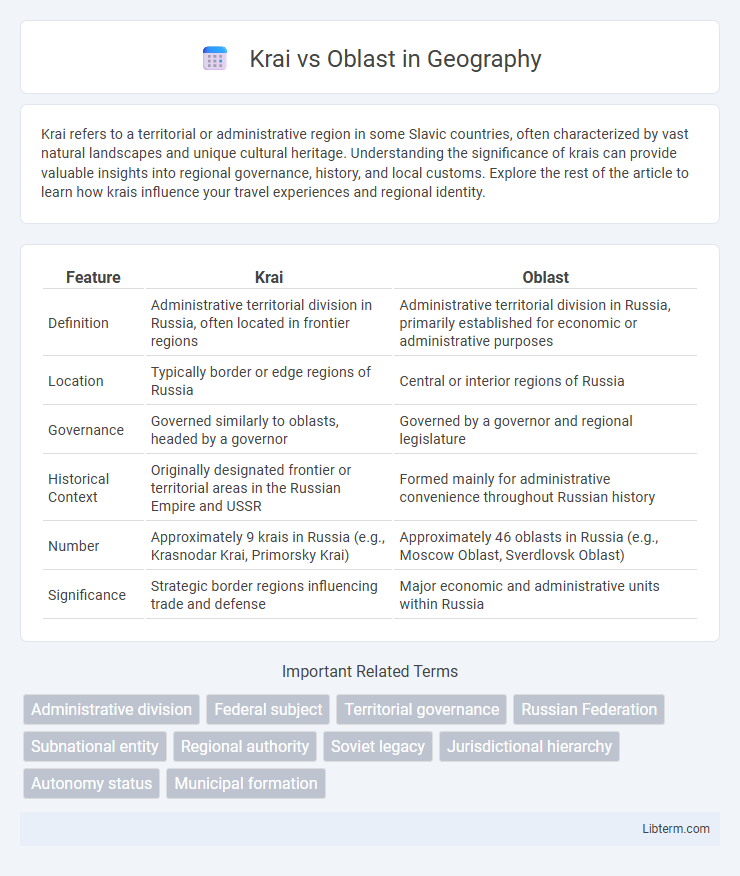Krai refers to a territorial or administrative region in some Slavic countries, often characterized by vast natural landscapes and unique cultural heritage. Understanding the significance of krais can provide valuable insights into regional governance, history, and local customs. Explore the rest of the article to learn how krais influence your travel experiences and regional identity.
Table of Comparison
| Feature | Krai | Oblast |
|---|---|---|
| Definition | Administrative territorial division in Russia, often located in frontier regions | Administrative territorial division in Russia, primarily established for economic or administrative purposes |
| Location | Typically border or edge regions of Russia | Central or interior regions of Russia |
| Governance | Governed similarly to oblasts, headed by a governor | Governed by a governor and regional legislature |
| Historical Context | Originally designated frontier or territorial areas in the Russian Empire and USSR | Formed mainly for administrative convenience throughout Russian history |
| Number | Approximately 9 krais in Russia (e.g., Krasnodar Krai, Primorsky Krai) | Approximately 46 oblasts in Russia (e.g., Moscow Oblast, Sverdlovsk Oblast) |
| Significance | Strategic border regions influencing trade and defense | Major economic and administrative units within Russia |
Introduction to Krai and Oblast
Krai and Oblast are both types of federal subjects in Russia, functioning as administrative divisions with similar legal status. Krais historically referred to frontier or border territories, often larger in area and sometimes granted more autonomy due to their strategic locations. Oblasts, by contrast, are typically established as more centrally located regions with administrative leadership appointed by the federal government.
Historical Origins of Krai and Oblast
Krais and oblasts are administrative divisions in Russia with distinct historical origins; krais traditionally referred to frontier territories established during Russia's eastward and southward expansions, serving as borderlands or military regions. Oblasts originated as general administrative units primarily in the Russian Empire and Soviet Union to manage internal territories with less strategic military importance. The historical development of krais reflects Russia's imperial military strategy, whereas oblasts evolved from centralized administrative reforms focused on civil governance.
Geographic Distribution
Krais and oblasts are both administrative divisions within Russia, with krais traditionally located along the country's edges, especially in the Far East, Siberia, and southern regions, while oblasts are more centrally distributed throughout European Russia and Western Siberia. Krais often cover larger, more remote, and less densely populated territories compared to oblasts, which typically encompass more urbanized and economically developed areas. The geographic distribution reflects historical expansion patterns and administrative organization, where krais served as frontier regions during Russia's territorial growth.
Administrative Structure and Governance
Krais and oblasts are both federal subjects of Russia with similar administrative structures, including a governor and a regional legislature. The primary difference lies in historical and geographical context rather than governance; krais traditionally refer to frontier or border regions, while oblasts denote more centrally located areas. Both entities operate under the same federal laws, maintaining equal status and powers within Russia's administrative framework.
Legal Definitions and Status
Krai and Oblast are both administrative divisions within the Russian Federation, distinguished primarily by historical and geographic context rather than legal differences. Legally, both possess equal status under Russian federal law, with similar legislative powers, governance structures, and administrative functions defined by the Constitution of Russia and the federal law on the general principles of organization of local self-government. The choice of the term "krai" or "oblast" often reflects regional historical traditions but does not imply any variance in political or legal authority.
Key Differences Between Krai and Oblast
Krai and Oblast are both administrative divisions in Russia, with key differences rooted in historical and geographical contexts. KraIs often refer to frontier territories with greater ethnic diversity and strategic importance, while Oblasts are typically more centralized and economically developed regions. Governance structures in KraIs may allow for slightly more local autonomy compared to Oblasts, reflecting their distinct administrative roles within the Russian Federation.
Cultural and Ethnic Significance
Krais and oblasts in Russia differ not only administratively but also in cultural and ethnic significance, with krais often encompassing larger territories that include diverse indigenous groups and ethnic minorities, reflecting a rich tapestry of traditions and languages. Oblasts typically represent more homogenized populations with predominant Russian cultural influences, though some oblasts also host significant ethnic communities contributing to regional cultural identities. The distinction impacts regional governance and cultural preservation efforts, as krais tend to embrace a broader multicultural heritage within their administrative frameworks.
Economic Roles and Development
Krais often cover larger, less densely populated areas with abundant natural resources, making their economies heavily reliant on mining, agriculture, and forestry, which drive regional development through resource extraction and export. Oblasts, typically more urbanized and industrialized, develop diversified economies focused on manufacturing, services, and technology sectors, fostering higher economic growth rates and attracting investment. Differences in infrastructure and government policies further shape the economic roles, with oblasts benefiting from better connectivity and more proactive economic planning compared to krais.
Notable Examples of Krai and Oblast
Notable examples of krais in Russia include Krasnoyarsk Krai, known for its vast Siberian forests and rich mineral resources, and Primorsky Krai, a key port region on the Pacific Ocean. Prominent oblasts include Moscow Oblast, surrounding Russia's capital with significant industrial and economic activity, and Leningrad Oblast, home to important historical sites near Saint Petersburg. These distinctions reflect administrative roles, with krais often covering frontier or expansive territories and oblasts typically representing more centralized regions.
Conclusion: Krai vs Oblast in Modern Russia
Krais and oblasts in modern Russia function as equivalent administrative divisions, both possessing similar legal status and governance structures under the Russian Federation. The distinction between krai and oblast primarily reflects historical and geographical factors rather than differences in political or administrative authority. This equivalence ensures uniform regional administration while preserving traditional naming rooted in Russia's territorial evolution.
Krai Infographic

 libterm.com
libterm.com